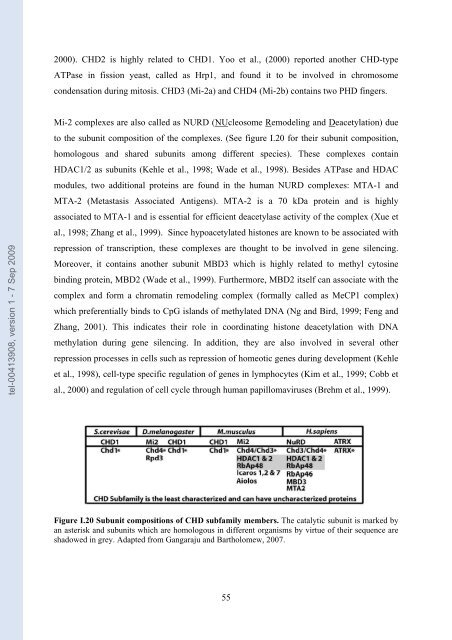Etudes sur le mécanisme de remodelage des nucléosomes par ...
Etudes sur le mécanisme de remodelage des nucléosomes par ...
Etudes sur le mécanisme de remodelage des nucléosomes par ...
Create successful ePaper yourself
Turn your PDF publications into a flip-book with our unique Google optimized e-Paper software.
tel-00413908, version 1 - 7 Sep 2009<br />
2000). CHD2 is highly related to CHD1. Yoo et al., (2000) reported another CHD-type<br />
ATPase in fission yeast, cal<strong>le</strong>d as Hrp1, and found it to be involved in chromosome<br />
con<strong>de</strong>nsation during mitosis. CHD3 (Mi-2a) and CHD4 (Mi-2b) contains two PHD fingers.<br />
Mi-2 comp<strong>le</strong>xes are also cal<strong>le</strong>d as NURD (NUc<strong>le</strong>osome Remo<strong>de</strong>ling and Deacetylation) due<br />
to the subunit composition of the comp<strong>le</strong>xes. (See figure I.20 for their subunit composition,<br />
homologous and shared subunits among different species). These comp<strong>le</strong>xes contain<br />
HDAC1/2 as subunits (Keh<strong>le</strong> et al., 1998; Wa<strong>de</strong> et al., 1998). Besi<strong>de</strong>s ATPase and HDAC<br />
modu<strong>le</strong>s, two additional proteins are found in the human NURD comp<strong>le</strong>xes: MTA-1 and<br />
MTA-2 (Metastasis Associated Antigens). MTA-2 is a 70 kDa protein and is highly<br />
associated to MTA-1 and is essential for efficient <strong>de</strong>acetylase activity of the comp<strong>le</strong>x (Xue et<br />
al., 1998; Zhang et al., 1999). Since hypoacetylated histones are known to be associated with<br />
repression of transcription, these comp<strong>le</strong>xes are thought to be involved in gene si<strong>le</strong>ncing.<br />
Moreover, it contains another subunit MBD3 which is highly related to methyl cytosine<br />
binding protein, MBD2 (Wa<strong>de</strong> et al., 1999). Furthermore, MBD2 itself can associate with the<br />
comp<strong>le</strong>x and form a chromatin remo<strong>de</strong>ling comp<strong>le</strong>x (formally cal<strong>le</strong>d as MeCP1 comp<strong>le</strong>x)<br />
which preferentially binds to CpG islands of methylated DNA (Ng and Bird, 1999; Feng and<br />
Zhang, 2001). This indicates their ro<strong>le</strong> in coordinating histone <strong>de</strong>acetylation with DNA<br />
methylation during gene si<strong>le</strong>ncing. In addition, they are also involved in several other<br />
repression processes in cells such as repression of homeotic genes during <strong>de</strong>velopment (Keh<strong>le</strong><br />
et al., 1998), cell-type specific regulation of genes in lymphocytes (Kim et al., 1999; Cobb et<br />
al., 2000) and regulation of cell cyc<strong>le</strong> through human papillomaviruses (Brehm et al., 1999).<br />
Figure I.20 Subunit compositions of CHD subfamily members. The catalytic subunit is marked by<br />
an asterisk and subunits which are homologous in different organisms by virtue of their sequence are<br />
shadowed in grey. Adapted from Gangaraju and Bartholomew, 2007.<br />
55

















